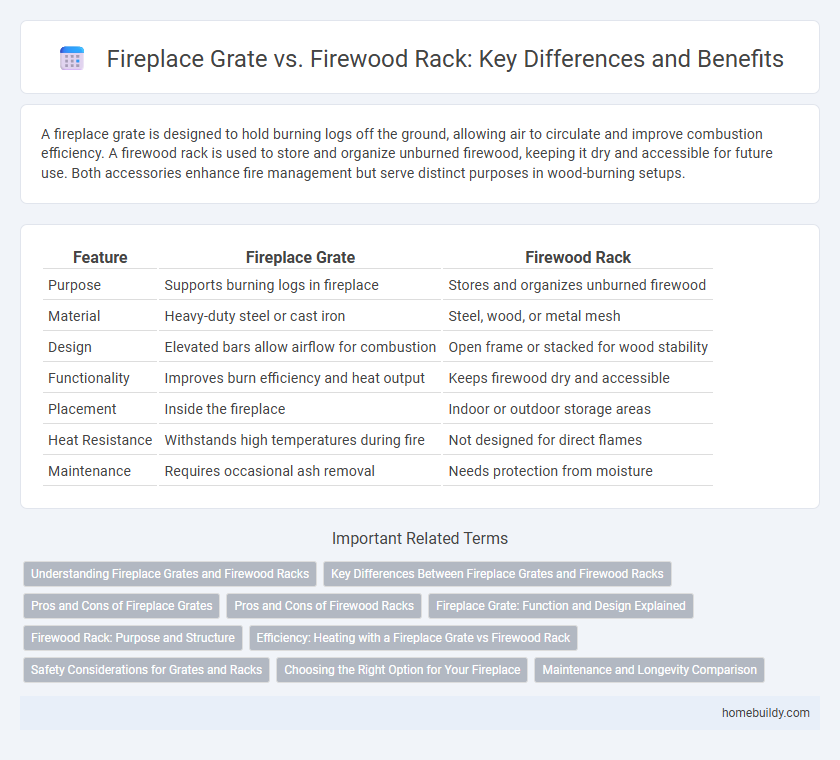A fireplace grate is designed to hold burning logs off the ground, allowing air to circulate and improve combustion efficiency. A firewood rack is used to store and organize unburned firewood, keeping it dry and accessible for future use. Both accessories enhance fire management but serve distinct purposes in wood-burning setups.
Table of Comparison
| Feature | Fireplace Grate | Firewood Rack |
|---|---|---|
| Purpose | Supports burning logs in fireplace | Stores and organizes unburned firewood |
| Material | Heavy-duty steel or cast iron | Steel, wood, or metal mesh |
| Design | Elevated bars allow airflow for combustion | Open frame or stacked for wood stability |
| Functionality | Improves burn efficiency and heat output | Keeps firewood dry and accessible |
| Placement | Inside the fireplace | Indoor or outdoor storage areas |
| Heat Resistance | Withstands high temperatures during fire | Not designed for direct flames |
| Maintenance | Requires occasional ash removal | Needs protection from moisture |
Understanding Fireplace Grates and Firewood Racks
Fireplace grates elevate firewood inside the fireplace, improving air circulation for more efficient combustion and heat output. Firewood racks serve as storage solutions outside the fireplace, keeping wood organized and dry before use. Understanding the distinct functions of fireplace grates and firewood racks helps optimize fire maintenance and safety in a home heating setup.
Key Differences Between Fireplace Grates and Firewood Racks
Fireplace grates are designed to elevate firewood off the fireplace floor, improving air circulation and enhancing combustion efficiency, while firewood racks primarily serve as storage units to keep firewood organized and dry before use. Fireplace grates typically feature sturdy metal bars that withstand high temperatures during burning, whereas firewood racks are often made from metal or wood and remain outside the fireplace. The key difference lies in their function: grates facilitate the burning process inside the fireplace, whereas racks focus on convenient and accessible firewood storage.
Pros and Cons of Fireplace Grates
Fireplace grates improve airflow for more efficient combustion and help contain burning logs safely within the fireplace, reducing mess and enhancing heat output. They may require regular cleaning to prevent ash buildup and might not accommodate large or irregularly shaped firewood compared to firewood racks, which provide convenient storage but don't assist with combustion. Choosing a fireplace grate offers better fire efficiency and protection but could involve more maintenance.
Pros and Cons of Firewood Racks
Firewood racks provide organized storage for logs, preventing moisture buildup and enhancing airflow, which helps maintain dry firewood ready for burning. However, firewood racks typically lack the heat resistance and durability required for direct use inside a fireplace, limiting their functionality compared to fireplace grates designed to withstand high temperatures. While firewood racks excel at outdoor storage and aesthetics, they do not facilitate efficient combustion or ash containment within the fireplace like grates do.
Fireplace Grate: Function and Design Explained
A fireplace grate is specifically designed to elevate firewood, allowing air to circulate underneath for efficient burning and reduced smoke. Its robust metal bars withstand high temperatures, ensuring durability and stability while holding logs in place. Unlike a firewood rack, which primarily stores wood outside the fire, a fireplace grate enhances combustion and heat output within the hearth.
Firewood Rack: Purpose and Structure
A firewood rack is designed primarily for storing and organizing firewood, keeping logs off the ground to prevent moisture and improve air circulation. Its sturdy metal or wooden frame provides a stable structure for stacking wood neatly, enhancing accessibility and maintaining dryness. Unlike fireplace grates, firewood racks are not meant for burning but serve as an efficient storage solution for seasoned firewood.
Efficiency: Heating with a Fireplace Grate vs Firewood Rack
A fireplace grate significantly enhances heating efficiency by elevating firewood, promoting better airflow and more complete combustion, which generates stronger, consistent heat. In contrast, a firewood rack primarily serves as storage and does not improve burning efficiency or heat output. Using a grate reduces smoke and increases warmth, making it a superior choice for optimizing fireplace performance.
Safety Considerations for Grates and Racks
Fireplace grates are designed to securely hold burning wood above the hearth, promoting airflow and reducing the risk of embers falling onto the floor, which enhances safety during use. Firewood racks primarily store unlit wood and are positioned away from the fire source to prevent accidental ignition, emphasizing safe wood storage rather than combustion management. Choosing the right equipment based on its function ensures proper fire containment and minimizes hazards related to sparks, heat exposure, and wood storage proximity.
Choosing the Right Option for Your Fireplace
Fireplace grates are designed to hold burning logs securely, allowing optimal airflow to enhance combustion and heat distribution, while firewood racks primarily store unburned wood safely and neatly. Selecting the right option depends on your needs: choose a fireplace grate for efficient burning and heat output within the hearth, or a firewood rack for convenient, organized storage of firewood outside or near the fireplace. Proper selection improves fireplace functionality and safety, ensuring a warm and tidy environment.
Maintenance and Longevity Comparison
A fireplace grate is designed to withstand high temperatures and direct flame exposure, requiring minimal maintenance beyond occasional ash removal, which contributes to its longevity. In contrast, a firewood rack, typically made from less heat-resistant materials, demands regular cleaning and protection from moisture to prevent rust and decay, thereby impacting its durability. Choosing a fireplace grate optimizes maintenance efforts and extends lifespan due to its robust construction tailored for indoor fire use.
Fireplace grate vs Firewood rack Infographic

 homebuildy.com
homebuildy.com